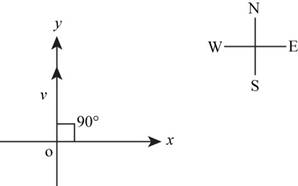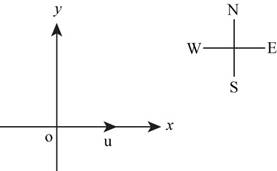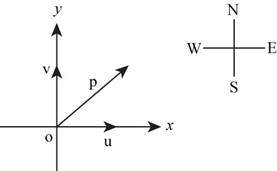
(a)
To express: The velocity of the wind as a
(a)
Answer to Problem 59E
The expression of wind velocity in component form is
Explanation of Solution
Given:
The speed of wind is
Formula used:
If velocity of wind is vector v which makes angle
Calculation:
The speed of wind is
The angle made by wind velocity with positive
Wind velocity vector v is shown on coordinate axis in Figure (1).

Figure (1)
Substitute
Thus, the component form of wind velocity v is
(b)
To express: The velocity of the jet relative to air in component form.
(b)
Answer to Problem 59E
Expression of jet velocity in component form relative to air is
Explanation of Solution
Given:
The speed of Jet is
Formula used:
If velocity of Jet is vector u which makes angle
Calculation:
The speed of Jet is
So, the angle made by Jet velocity vector with positive
Jet velocity vector is shown in Figure (2).

Figure (2)
Substitute
Thus, component form of Jet velocity u is
(c)
To find: The true velocity of Jet as a vector.
(c)
Answer to Problem 59E
True velocity of jet as a vector is
Explanation of Solution
Given:
The speed of wind is
The speed of Jet is
Formula used:
If vector u is
Calculation:
If true velocity of jet is vector p , then vector p will be the resultant sum of wind velocity v and jet velocity u.
Figure (3) shows the vector u, vector v and vector p on coordinate axis.

Figure (3)
From section (b) jet velocity u is
Substitute
And vector p is
Therefore,
Thus true velocity of jet is
(d)
To find: True speed and direction of Jet.
(d)
Answer to Problem 59E
True speed of jet is
Explanation of Solution
Given:
The speed of Jet relative to air is
Formula used:
If
Where,
Calculation:
From Section (c), the true velocity of jet is
Substitute
Therefore true speed of jet is
If
From section (c), true velocity vector of jet is
Thus,
Solve for
So, direction is
Therefore, the true speed of jet is
Chapter 9 Solutions
Precalculus: Mathematics for Calculus - 6th Edition
- The spread of an infectious disease is often modeled using the following autonomous differential equation: dI - - BI(N − I) − MI, dt where I is the number of infected people, N is the total size of the population being modeled, ẞ is a constant determining the rate of transmission, and μ is the rate at which people recover from infection. Close a) (5 points) Suppose ẞ = 0.01, N = 1000, and µ = 2. Find all equilibria. b) (5 points) For the equilbria in part a), determine whether each is stable or unstable. c) (3 points) Suppose ƒ(I) = d. Draw a phase plot of f against I. (You can use Wolfram Alpha or Desmos to plot the function, or draw the dt function by hand.) Identify the equilibria as stable or unstable in the graph. d) (2 points) Explain the biological meaning of these equilibria being stable or unstable.arrow_forwardFind the indefinite integral. Check Answer: 7x 4 + 1x dxarrow_forwardshow sketcharrow_forward
- Find the indefinite integral. Check Answer: 7x 4 + 1x dxarrow_forwardQuestion 1: Evaluate the following indefinite integrals. a) (5 points) sin(2x) 1 + cos² (x) dx b) (5 points) t(2t+5)³ dt c) (5 points) √ (In(v²)+1) 4 -dv ขarrow_forwardFind the indefinite integral. Check Answer: In(5x) dx xarrow_forward
- Find the indefinite integral. Check Answer: 7x 4 + 1x dxarrow_forwardHere is a region R in Quadrant I. y 2.0 T 1.5 1.0 0.5 0.0 + 55 0.0 0.5 1.0 1.5 2.0 X It is bounded by y = x¹/3, y = 1, and x = 0. We want to evaluate this double integral. ONLY ONE order of integration will work. Good luck! The dA =???arrow_forward43–46. Directions of change Consider the following functions f and points P. Sketch the xy-plane showing P and the level curve through P. Indicate (as in Figure 15.52) the directions of maximum increase, maximum decrease, and no change for f. ■ 45. f(x, y) = x² + xy + y² + 7; P(−3, 3)arrow_forward
 Calculus: Early TranscendentalsCalculusISBN:9781285741550Author:James StewartPublisher:Cengage Learning
Calculus: Early TranscendentalsCalculusISBN:9781285741550Author:James StewartPublisher:Cengage Learning Thomas' Calculus (14th Edition)CalculusISBN:9780134438986Author:Joel R. Hass, Christopher E. Heil, Maurice D. WeirPublisher:PEARSON
Thomas' Calculus (14th Edition)CalculusISBN:9780134438986Author:Joel R. Hass, Christopher E. Heil, Maurice D. WeirPublisher:PEARSON Calculus: Early Transcendentals (3rd Edition)CalculusISBN:9780134763644Author:William L. Briggs, Lyle Cochran, Bernard Gillett, Eric SchulzPublisher:PEARSON
Calculus: Early Transcendentals (3rd Edition)CalculusISBN:9780134763644Author:William L. Briggs, Lyle Cochran, Bernard Gillett, Eric SchulzPublisher:PEARSON Calculus: Early TranscendentalsCalculusISBN:9781319050740Author:Jon Rogawski, Colin Adams, Robert FranzosaPublisher:W. H. Freeman
Calculus: Early TranscendentalsCalculusISBN:9781319050740Author:Jon Rogawski, Colin Adams, Robert FranzosaPublisher:W. H. Freeman
 Calculus: Early Transcendental FunctionsCalculusISBN:9781337552516Author:Ron Larson, Bruce H. EdwardsPublisher:Cengage Learning
Calculus: Early Transcendental FunctionsCalculusISBN:9781337552516Author:Ron Larson, Bruce H. EdwardsPublisher:Cengage Learning





